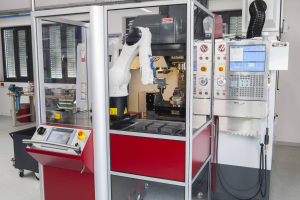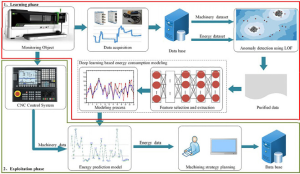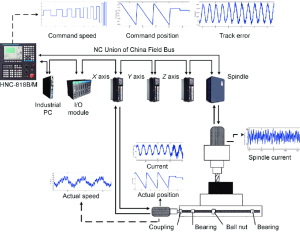Application Process and Required Technologies of Autonomous CNC Systems
Autonomous CNC (Computer Numerical Control) systems offer advanced automation, data integration, and continuous improvement solutions compared to traditional CNC machines. Their integration into industrial production processes provides significant gains in efficiency, flexibility, and quality. However, the successful implementation of these systems requires a carefully planned application process and suitable technological infrastructure. Below are the steps to follow and the necessary technologies for the integration of autonomous CNC systems.

1. Application Steps: Integrating Autonomous CNC Systems into Industrial Production
a. Infrastructure Assessment and Preparation
The first step in integrating autonomous CNC systems into industrial production is a comprehensive evaluation of the existing production infrastructure. This step is crucial to identify the technology requirements and existing gaps in the infrastructure.
- Analysis of the current machine park: The compatibility of the CNC machines’ current hardware and software structures with autonomous processing systems is assessed. Modifications for older machines or the proposal of entirely new systems may be suggested.
- Establishment of IoT infrastructure: For autonomous machines to operate correctly, data communication between machines is essential. During this stage, IoT devices (sensors, connection points) are installed to enable data transmission between machines.
- Installation of sensors and data collection devices: Machines are equipped with high-precision sensors. These sensors monitor the processing process, collect data, and the data is then analyzed.

b. Artificial Intelligence and Machine Learning Implementation
Artificial intelligence and machine learning are technologies that enhance the efficiency of autonomous CNC machines. These technologies allow the system to continuously learn and optimize productivity.
- Data analysis and modeling: Autonomous CNC machines analyze historical production data using artificial intelligence algorithms. These analyses help adjust processing parameters optimally.
- Machine learning: Machine learning algorithms monitor machine performance and over time, especially for the processing of complex parts, learn the most efficient methods. This enables faster and lower-cost production.
c. Real-time Monitoring and Condition Detection
In autonomous CNC systems, real-time monitoring ensures that every stage of the production process is accurately tracked. This monitoring allows the system to detect maintenance needs in advance.
- Data collection and transmission: Sensors continuously collect data on temperature, vibration, pressure, and speed of machines. This data is transmitted to a central data storage unit via IoT networks.
- Condition detection: Artificial intelligence and machine learning algorithms analyze the data to detect abnormalities in machines. Thus, potential failures are identified in advance, and maintenance processes are optimized.


2. Essential Technologies
a. IoT (Internet of Things) and Connected Devices
IoT is one of the key technologies that form the foundation of autonomous CNC systems. This technology allows machines to share data with each other and with central control units.
- Connected sensors: Sensors that monitor parameters such as temperature, vibration, speed, and pressure are used in machines. These sensors provide critical data about the machine’s operation.
- Data transmission networks: High-speed data transmission networks such as Wi-Fi, 5G, and LoRaWAN are used to ensure fast and secure data transfer.
b. Artificial Intelligence and Machine Learning (AI/ML)
For autonomous CNC systems to operate more efficiently, integrating artificial intelligence (AI) and machine learning (ML) technologies is crucial.
- Advanced algorithms: AI algorithms analyze production data to optimize processing routes. These algorithms help make the processes more efficient.
- Machine learning: Machine learning applications within the system allow machines to improve over time. This learning process results in lower energy consumption, reduced processing times, and increased quality.


c. Sensors and Data Collection Systems
Sensors are critical for ensuring the accurate and reliable operation of autonomous CNC machines. These sensors allow the system to monitor environmental conditions and gain insights into the machine’s condition.
- Vibration sensors: Monitor whether the machines are operating smoothly.
- Temperature sensors: High temperatures often indicate wear or breakage risks. These sensors monitor machine performance and provide early warnings.
- Load detection sensors: Monitoring the load applied to the workpiece helps determine whether machines are operating correctly.
d. Cloud Computing and Data Storage
Cloud computing plays a significant role in storing, analyzing, and accessing data from autonomous CNC machines.
- Data access and sharing: Cloud platforms enable production managers to access data from machines from anywhere.
- Data analytics and optimization: Cloud-based analytical tools process large datasets and provide insights to improve machine performance.
- Flexibility and scalability: The cloud environment offers a flexible platform for storing and processing data, enabling access to data from machines anytime, anywhere.
e. Robotics and Automated Processing Technologies
Autonomous CNC machines are supported by robotics and automated processing technologies, making production processes more efficient.
- Automatic loading and unloading: Workpieces are automatically placed onto and removed from CNC machines. This increases production continuity and reduces labor costs.
- Robotic arms and transport systems: Automates material handling and processing tasks, thereby enhancing efficiency on the production line.

3. Integration of Autonomous CNC Systems in Industrial Applications
a. Flexible Manufacturing Systems (FMS)
Autonomous CNC machines work in integration with Flexible Manufacturing Systems (FMS), enabling quick transitions between different workpiece types in production processes. These systems provide automatic program generation, tool changes, and continuous data analysis along the production line to enhance manufacturing flexibility.
b. Quality Control and Monitoring
Autonomous CNC machines can be equipped with advanced quality control systems to maintain high quality in production processes. These systems include visual inspection and tactile measurement systems for workpiece quality control.
- Real-time quality inspection: Optical sensors and tactile measurement systems immediately detect defects in the workpieces and suggest necessary corrections.
- Minimizing defect rates: Automatic inspections reduce defect rates and improve production quality.
c. Predictive Maintenance
Predictive maintenance ensures the continuous efficiency of autonomous CNC machines. Sensor data is analyzed to predict failures and plan maintenance activities.
- Early warning systems: The lifespan of machine parts and maintenance schedules are predicted based on sensor data.
- Reducing failure risks: Early detection of potential failures minimizes production downtime and increases machine efficiency.
Conclusion and Looking to the Future
The integration of autonomous CNC systems into industrial production offers significant potential to make manufacturing processes more efficient, flexible, and error-free. For the successful implementation of these systems, the integration of advanced technologies such as IoT, artificial intelligence, robotics, and sensor technologies is critical. With proper planning for infrastructure, data collection, system integration, and continuous improvement stages, autonomous CNC systems can make production processes faster, more reliable, and cost-effective. In the future, with the development of these systems, smart factories and continually learning production systems will open the door to a more efficient and sustainable manufacturing world.








